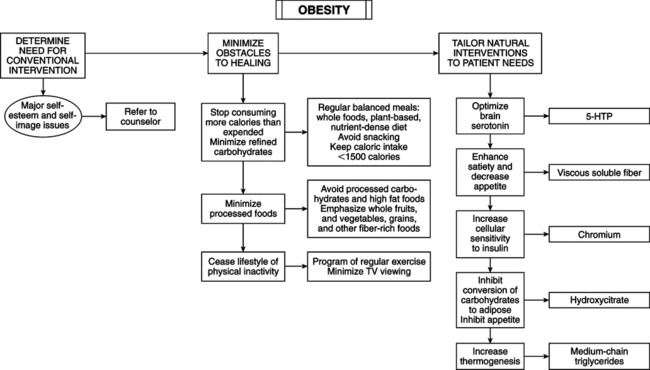• Obesity is a major contributor to mortality risk. Definition: excessive body fat distinguished from being overweight (excess body weight relative to height). A muscular athlete may be overweight but have a low body fat percentage. Body weight alone is not an index of obesity. BMI is the standard for classifying body composition. BMI correlates well to total body fat. BMI calculation: BMI = (pounds × 703)/square inches (height) Metric: BMI = kilograms/square meters (height) Classification of Body Mass Index • Stated weight ranges merely reflect weights of those with lowest mortality rate of insured persons, which may not reflect U.S. population. • Weight ranges for lowest mortality rate do not necessarily reflect optimal healthy weight for height. • Standard values make assessing degree of obesity difficult; a person within proper weight range may have excess fat and lower than optimal lean body mass, and a person with increased musculature may be “overweight” despite low body fat per-centage. • Obese persons have 50%-100% increased risk of death from all causes. Most of the risk is from cardiovascular causes: type 2 diabetes mellitus (DM), elevated cholesterol, hypertension, and atherosclerosis. • Determination of body composition: obesity is defined as body fat percentage >30% for women and >25% for men. Indirect methods of measurement must be used. • Visual observation: qualitative analysis of obesity. Classifying by body types (somatotyping) is the physical anthropologic classification of physique based on body size and proportion: • Distribution of body fat: gynecoid (female) and android (male). See the section on the types of obesity. • Skinfold/fat fold thickness: measuring thickness of subcutaneous fat (skinfold or fat fold thickness) with skinfold calipers at several sites to improve accuracy—triceps, biceps, subscapular, suprailiac skinfolds. Limitations: inability to control intersubject and intrasubject variation in skinfold compressibility; inability to palpate fat/muscle interface; impossibility of obtaining interpretable measurements on very obese persons; interobserver variability; errors from use of different types of calipers. Skinfold measurements give easiest and least expensive method for estimating fat percentage. More precise tools: bioelectrical impedance, ultrasound, total body electrical conductivity, hydrostatic weighing. Body Fat Rating Chart for Use With a Body Fat Measuring Scale • Measurement of body density: quantitative measure of body fat determined from specific gravity by measuring different weights of body in and out of water. Weigh patient under water and out of water, taking into account residual volume of lungs. Factual basis: fat is lighter than water; other tissues are heavier than water. This is the gold standard of body composition determination. Limitation of hydrostatic weighing: requires subject cooperation to exhale completely and then submerge completely under water up to 10 times—impossible for elderly, ill, or hospitalized patients. • Bioelectrical impedance: measures conduction of applied electrical current through body tissues. In biologic structures, constant low-level AC current results in impedance to flow of current that is frequency dependent, according to type of tissue. Fluids act as electrical conductors; cell membranes act as electrical condensers. At low frequencies (1 kHz), current mainly passes through extracellular fluids; at higher frequencies (500-800 kHz), it penetrates intracellular and extracellular fluids. Fat-free mass has greater conductivity than fat does, explaining the strong relation between conductance and lean body mass. This method is safe, noninvasive, and rapid. Home scales with bioelectrical impedance are available for $50-$200. • Hyperplastic obesity: increased number of fat cells throughout body; dependent on the diet of the mother while in utero and early infant nutrition. Excess calories during early stages of development increase number of fat cells for life. Hyperplastic obesity begins in childhood and is linked to fewer serious health effects. • Hypertrophic obesity: increased size of fat cells; linked to DM, heart disease, hypertension. Fat distribution is around waist, considered male patterned or android. Android obesity is a waist larger than hips. In female-patterned or gynecoid obesity, the hips are larger. Waist/hip ratio: measure waist circumference one half inch above navel; measure hips circumference at the greatest protrusion of buttocks. Divide waist circumference by hip circumference. Ratio >1.0 for men and >0.8 for women is linked to metabolic syndrome (syndrome X) and increases risk of type 2 DM, hypertension, coronary heart disease, stroke, and gout. • Hyperplastic-hypertrophic obesity: increase in number and size of fat cells.
Obesity
GENERAL CONSIDERATIONS
Classification of Body Mass Index
Underweight
<18.5
Normal
18.5-24.9
Overweight
24.9-29.9
Obesity
30.0-39.9
Extreme obesity
>40.0

Prevalence
Age (Years)
Risky
Excellent
Good
Fair
Poor
Male
19-24
<6%
10.8%
14.9%
19.0%
23.3%
25-29
<6%
12.8%
16.5%
20.3%
24.4%
30-34
<6%
14.5%
18.0%
21.5%
25.2%
35-39
<6%
16.1%
19.4%
22.6%
26.1%
40-44
<6%
17.5%
20.5%
23.6%
26.9%
45-49
<6%
18.6%
21.5%
24.5%
27.6%
50-54
<6%
19.8%
22.7%
25.6%
28.7%
55-59
<6%
20.2%
23.2%
26.2%
29.3%
60+
<6%
20.3%
23.5%
26.7%
29.8%
Female
19-24
<9%
18.9%
22.1%
25.0%
29.6%
25-29
<9%
18.9%
22.0%
25.4%
29.8%
30-34
<9%
19.7%
22.7%
26.4%
30.5%
35-39
<9%
21.0%
24.0%
27.7%
31.5%
40-44
<9%
22.6%
25.6%
29.3%
32.8%
45-49
<9%
24.3%
27.3%
30.9%
34.1%
50-54
<9%
26.6%
29.7%
33.1%
36.2%
55-59
<9%
27.4%
30.7%
34.0%
37.3%
60+
<9%
27.6%
31.0%
34.4%
38.0%

Types of Obesity
![]()
Stay updated, free articles. Join our Telegram channel

Full access? Get Clinical Tree


Obesity
